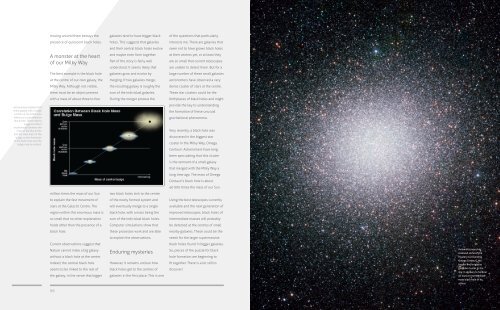Sol Lucet Omnibus - ESO
Sol Lucet Omnibus - ESO
Sol Lucet Omnibus - ESO
- TAGS
- lucet
- omnibus
- www.eso.org
Create successful ePaper yourself
Turn your PDF publications into a flip-book with our unique Google optimized e-Paper software.
Astronomers believe that<br />
every galaxy with a bulge<br />
of stars at its centre also<br />
harbours a supermassive<br />
black hole. Observations<br />
suggest a direct<br />
relationship between the<br />
mass of the black hole<br />
and the total mass of the<br />
bulge, so the formation<br />
of the black hole and the<br />
bulge may be related.<br />
moving around them betrays the<br />
presence of quiescent black holes.<br />
A monster at the heart<br />
of our Milky Way<br />
The best example is the black hole<br />
at the centre of our own galaxy, the<br />
Milky Way. Although not visible,<br />
there must be an object present<br />
with a mass of about three to four<br />
million times the mass of our Sun<br />
to explain the fast movement of<br />
stars at the Galactic Centre. The<br />
region within this enormous mass is<br />
so small that no other explanation<br />
holds other than the presence of a<br />
black hole.<br />
Current observations suggest that<br />
Nature cannot make a big galaxy<br />
without a black hole at the centre.<br />
Indeed, the central black hole<br />
seems to be linked to the rest of<br />
the galaxy, in the sense that bigger<br />
88<br />
galaxies tend to have bigger black<br />
holes. This suggests that galaxies<br />
and their central black holes evolve<br />
and maybe even form together.<br />
Part of the story is fairly well<br />
understood. It seems likely that<br />
galaxies grow and evolve by<br />
merging. If two galaxies merge,<br />
the resulting galaxy is roughly the<br />
sum of the individual galaxies.<br />
During the merger process the<br />
two black holes sink to the centre<br />
of the newly formed system and<br />
will eventually merge to a single<br />
black hole, with a mass being the<br />
sum of the individual black holes.<br />
Computer simulations show that<br />
these processes work and are able<br />
to explain the observations.<br />
Enduring mysteries<br />
However, it remains unclear how<br />
black holes get to the centres of<br />
galaxies in the first place. This is one<br />
of the questions that particularly<br />
interests me. There are galaxies that<br />
seem not to have grown black holes<br />
at their centres yet, or at least they<br />
are so small that current telescopes<br />
are unable to detect them. But for a<br />
large number of these small galaxies<br />
astronomers have observed a very<br />
dense cluster of stars at the centre.<br />
These star clusters could be the<br />
birthplaces of black holes and might<br />
provide the key to understanding<br />
the formation of these unusual<br />
gravitational phenomena.<br />
Very recently, a black hole was<br />
discovered in the biggest star<br />
cluster in the Milky Way, Omega<br />
Centauri. Astronomers have long<br />
been speculating that this cluster<br />
is the remnant of a small galaxy<br />
that merged with the Milky Way a<br />
long time ago. The mass of Omega<br />
Centauri’s black hole is about<br />
40 000 times the mass of our Sun.<br />
Using the best telescopes currently<br />
available and the next generation of<br />
improved telescopes, black holes of<br />
intermediate masses will probably<br />
be detected at the centres of small<br />
nearby galaxies. These could be the<br />
seeds for the larger supermassive<br />
black holes found in bigger galaxies.<br />
So, pieces of the puzzle for black<br />
hole formation are beginning to<br />
fit together. There is a lot still to<br />
discover!<br />
89<br />
A new discovery has<br />
resolved some of the<br />
mystery surrounding<br />
Omega Centauri, the<br />
largest and brightest<br />
globular cluster in the<br />
sky: it appears to harbour<br />
an elusive intermediatemass<br />
black hole in its<br />
centre.

















